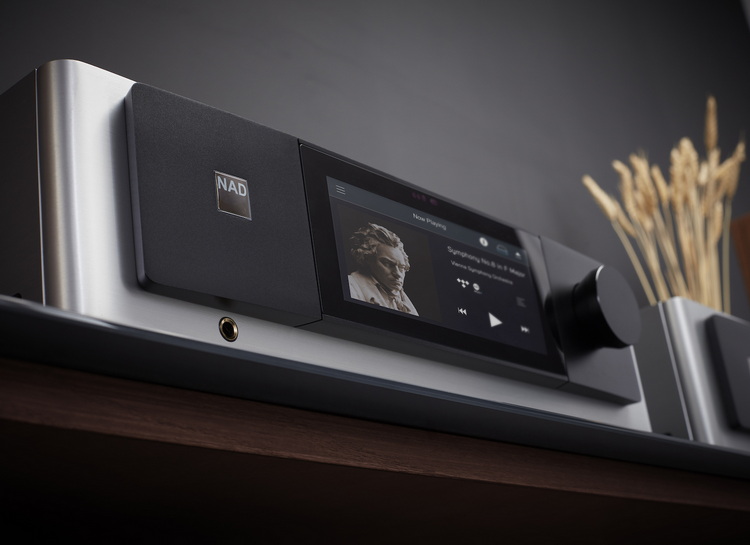REVIEW: NAD M33 – Many music lovers are eagerly awaiting the NAD M33. The desire of many is great. And not because this would ‘just’ be the larger, more audiophile version of the groundbreaking M10 amplifier that attracted so many people who would never normally invest in hi-fi. Yes, the M33 does indeed share a number of things with that small powerhouse, such as the excellent streaming options, the large touch screen and the Dirac room correction. But the engine that powers everything is completely different.
After a year of hints that they were brooding on something special at NAD ( such as an agreement with Purifi ) and after the introduction at the CES show in January (when there was such a thing as a big show), the special M33 amplifier finally reaches our test room – via a last detour in Waalwijk . A real first, because the corona virus has made the production of this device and the logistics side quite complex. NAD eventually had to fly in the first models for reviewers, it will not be in the store for a few weeks.
Why is the M33 so special now? To begin with, it is an all-rounder: streamer, DAC, phono preamplifier and amplifier in one. Have we forgotten something? It’s possible. Let’s stick to ‘one box that does everything’, without dragging in a Ban on the Ring joke, please. Just like the small M10, you could say, but with a more audiophile approach. Read: more possibilities, more inputs, more power. The latter is possible thanks to a brand new reinforcement section (Eigentakt) developed by renowned designer Bruno Putszeys and built by NAD itself. There is a fascinating technical story behind it, which appeals to the technician, but music lovers who only care about the experience will also find everything their heart desires in the M33.
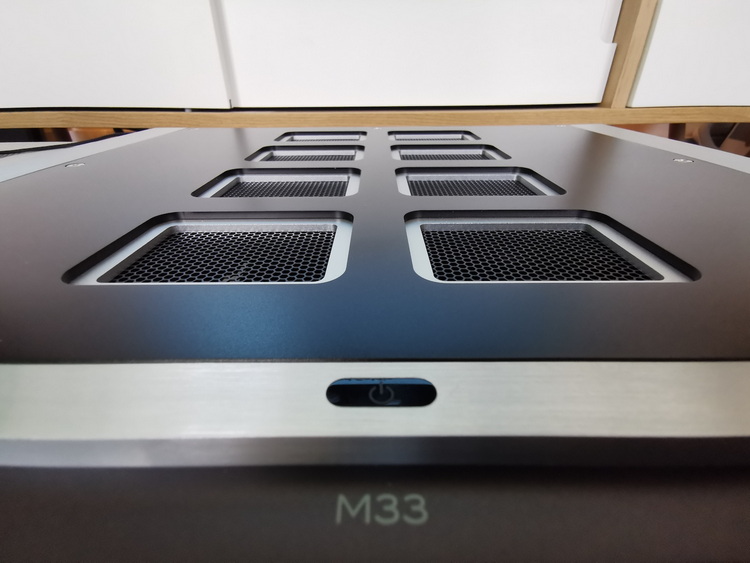
If the frisky melody of Yann Tiersen’s ‘Summer 78’ (for once in the performance by Jeroen van Veen, although we secretly think Tiersen’s own version is better) echoes through the room at the start of our test, we already know for sure: here we are going to have fun.
NAD M33: Familiar master design
With the introduction of the M12 a few years ago, NAD introduced a new design language for its Master range devices. Ok, the small M10 differs from it because it is really a very special device, but all other Master devices come out with the same marriage of brushed aluminum and black surfaces. As with its peers, the M33 ‘pops’ a black front panel from the silver-colored front, which, together with the characteristic ventilation openings at the top, provides a modern look.
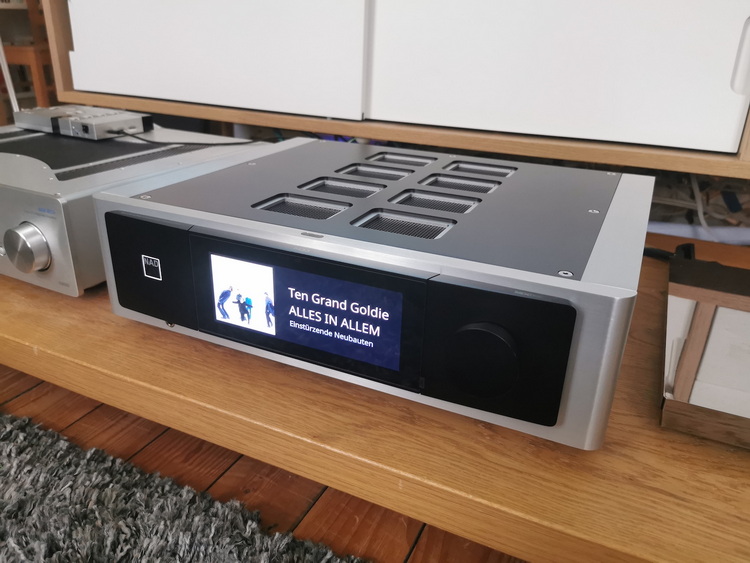
At the time with the M12, we already thought it: this design is quite a bold statement from NAD, because it stays far away from retro-classic designs with VU meters (but fans of, keep reading!) That many high-end brands love. At the same time, it does not look hyper-futuristic, so that you do not have a device that will look totally outdated in a few years. However, the Master design does not immediately show off its premium value. It is only when you get close and see how thoroughly the device is put together that you realize that this really is a luxurious product. We are going to have to disappoint audiophiles who equate quality with a permanent back injury. The M33 doesn’t weigh that much, thanks to that feather-light Class D technology.
With the M33, NAD again takes the future-fi approach by equipping the integrated amplifier with a large touch screen. That screen replaces almost all buttons, except for the volume control and the almost invisible power key at the top. We also thought the removal of physical buttons on the small M10 was a smart move. On the one hand, an audio device looks less ‘technical’ (because fewer buttons), but on the other hand you can make the controls as extensive as you want via a touchscreen. After all, you can work contextually and just show what is needed at that moment.
Operation via a touch screen also comes across as very natural for smartphone and tablet adapters – and who is not nowadays? At the same time, the touch screen is a bit of a gimmick in terms of operation. In most cases, the M33 will be close to your speakers, three or more meters away from you. Do you get out of your chair to change something via a screen while you also have a nice remote in hand and a full app on your tablet? Maybe not. The screen is nice again because album covers are displayed large. Or, if you prefer, you can also watch digital VU meters dancing to the music. Eyecandy.
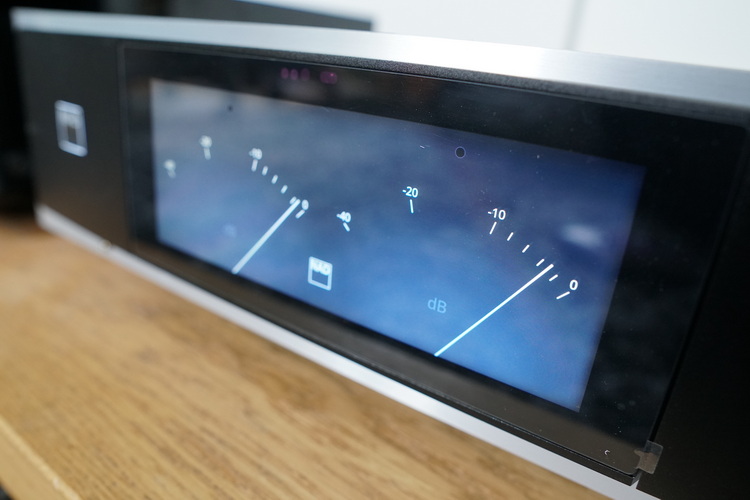
The next step
The M33 looks good, but in this case the more technical audiophile is perhaps even more fascinated by what is under that beautiful hood. After all, with this amplifier, NAD is taking the next step in their great love affair with Class D, by leaving their previous favorite amplification technology – nCore – for something completely new: Self-actuation. The Canadian company has a habit of looking for techniques for its flagships that are the best at the time and that suit them. That is also why it chose nCore from Hypex until recently. The M33 is therefore for something new, although there is at least a spiritual link with that nCore. After all, the NAD is the first consumer device with an Eigentakt amplification module from Purifi.
Self-touch is a class D technique, totally new and according to the makers also the ultimate that is possible. Let’s think quietly ‘up to this point’ for a moment, because who knows what Putzeys and co will get up to in a few years, although the designer indicates in interviews that we may not expect much more profit in certain areas. But what does ‘ultimate’ mean in this context? Virtually no noise, hardly any distortion (actually none in real-life terms), very high efficiency and almost total insensitivity to the ‘load’ (read: the speakers). That Eigentakt name has nothing to do with mopeds, but refers to the self-oscillating design that optimizes feedback so that distortion disappears in practical terms (if you are an engineer: THD and IMD would be less than 0,
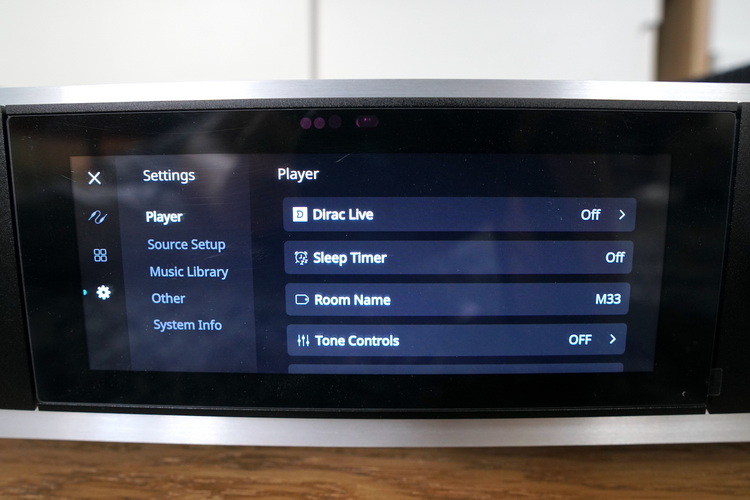
The M33 boasts 200 Watts of continuous power (both at 4 and 8 Ohms), which is really something. If you were to drive this monster towards clipping, it would appear less harsh than with classic Class D designs.
Streaming and more
The NAD M33 is an integrated amplifier with a relatively large number of inputs for sources such as a CD player and yes, a turntable is also welcome. The emphasis is more on digital inputs, which makes sense given the underlying philosophy. After all, NAD sees the M33 not only as a classic integrated amplifier, but also really puts the DAC function at the center. That is why there may be eight digital inputs (HDMI, USB, LAN, 2 x coax, 2 x optical and 1 x AES / EUB) and three analog (MM / MC phono, 1 x balanced XLR, 1 x cinch). So you can continue with that. By the way, the analog inputs are always internally converted to digital – otherwise you wouldn’t be able to perform digital DSP interventions. Not everyone will think that is a good move. Anyway, it may already be clear that the M33 is not a device for the old-school purist.
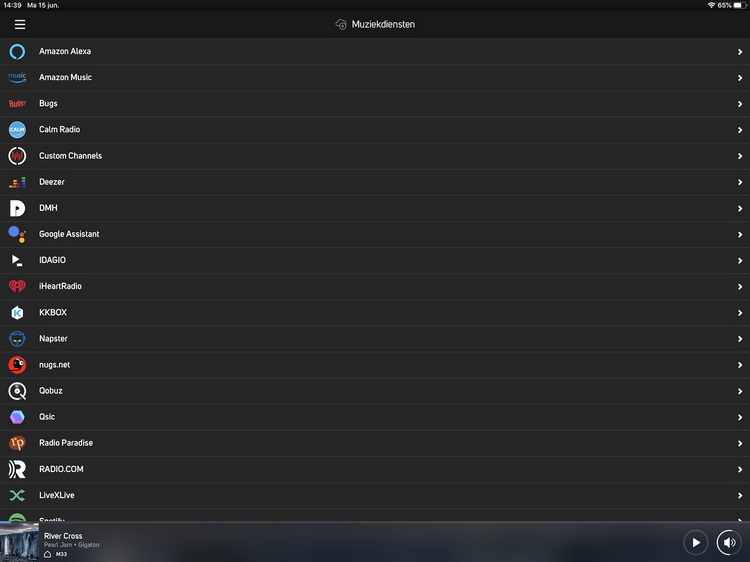
For more and more people, streaming is what it’s all about. Select music on the smartphone and then play it. That the M33 is well endowed in this area will probably not surprise anyone, given the roots of the device. As you would expect, NAD is betting on BluOS for streaming. Not a bad choice, because this platform also powers the Bluesound devices and can be found in other devices (such as DALI’s active Rubicon and Callisto lines ). In terms of support for streaming services, BluOS scores well and you can also easily play your own hi-res files, both from a NAS or from a USB disk that you connect to the (slightly less easily accessible) USB port at the back of the amplifier.
BluOS gives the NAD M33 two major advantages: you operate the amplifier via the user-friendly BluOS app and you can combine the amplifier with other BluOS devices in your home. Playing a Spotify playlist simultaneously in the living room (via the M33), in the dining room (via a pair of Bluesound speakers) and in the kitchen (via built-in speakers connected to a Bluesound Powernode amplifier), it is very easy.
The BluOS app is very user-friendly, especially on a tablet, and presents beautifully. Although Chromecast is not an option, you can control the M33 with voice via Google Assistant. You create the link between Google and your amplifier in the app. What we find very positive: The BluOS app is also more than an access to streaming options, which makes it superior to platforms such as Chromecast in some situations. In the app you can select the physical inputs, adjust settings and even switch between Dirac filters, if you have created one. All these things can of course also be done via the touch screen – but bet you never will.
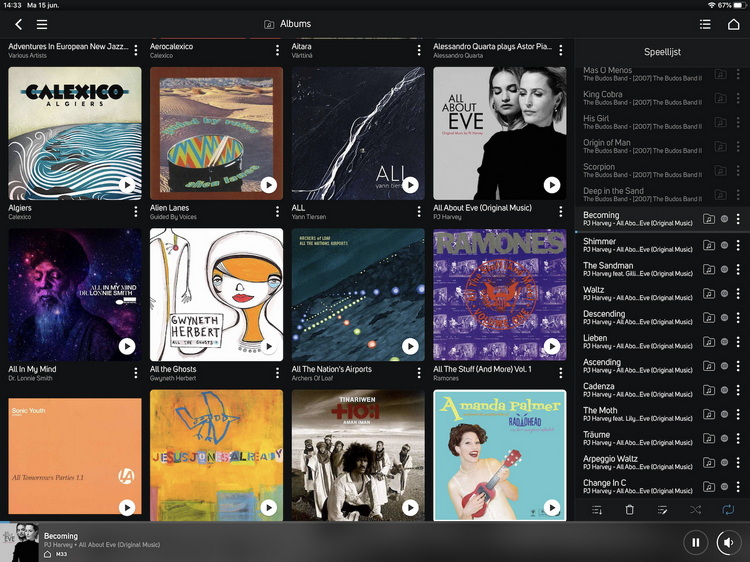
And other streaming options? The main fallback option is AirPlay 2. This way you have a fully-fledged alternative to BluOS, as long as you have an iPad, iPhone or Apple computer at home. Also to link speakers, because via a menu on an Apple device you can send an album on Apple Music to an M33 and a Sonos One speaker in the veranda at the same time. Are you a Spotify subscriber? Then you can send music directly to the M33 from the Spotify app.
There is also the option Bluetooth. Usually not our favorite choice because you are guaranteed to work lossy, but the NAD M33 does support aptX HD so that you can stream in the least poor quality. Bonus: the Bluetooth module works in two directions. So you can also connect wireless headphones late at night for that last movement
Like other recent NADs, the NAD M33 is functionally Roon Ready, an important requirement for an audiophile product. Officially not yet certified (and it can take a while, we noticed with the C 658 , which is still not approved), so you don’t get to see a nice miniature icon of the amplifier in Roon. But during the weeks that we had the M33 on test, streaming via Roon worked completely as it should.
Yes, TV sound too
What is sad? Spend a nice amount for a music solution and still have to listen to inferior TV speakers if you decide to binge-watch a series on Netflix. Yes, you can more or less solve the problem with a soundbar, but then you opt for an extra device in the living room. And that with a sub-optimal result – while a high-end stereo solution simply shines in the same room. Why not just use this system for your next Star Wars marathon? Give John Williams the view he deserves!
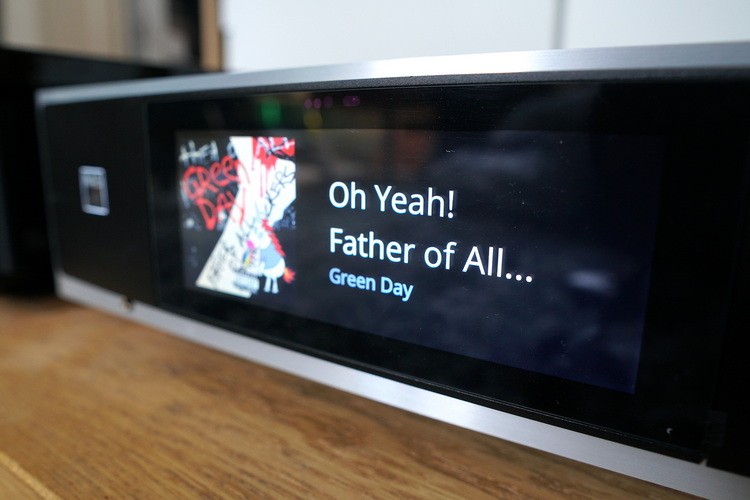
There is, of course, a reason why people don’t often take the plunge to hook up their TV to their stereo system. Often the optical cable is the only option. That works, but in terms of integration it is far from perfect. If you want to adjust the volume, you have to look for the remote of the amplifier. You can call NAD a pioneer in the trend to do something about this. The M33 is, just like the M10 (and optionally with the C 658 and other NADs) equipped with an HDMI-ARC input. Use an HDMI cable to connect to your TV and you’re done. Quieter or louder, you can control that via the remote control of the television. It is smart to enable the auto-sensing option in the settings, so that the amplifier automatically switches to the HDMI input when there is TV sound. You may also have to set PCM output in the TV settings, because the M33 does not process Dolby Digital or other surround codecs. Important, because otherwise you will only see Ricky Gervais but not hear him speak when you sacrifice an evening to the second season of the pitch-black ‘After Life’. Certainly do – even though you may wish the sound to disappear in the scenes at the psychologist.
Surround with discrete speakers remains a superior experience with movies, you should not doubt that. But if a room full of speakers is not an option, then a stereo setup with speakers placed symmetrically next to the screen is really not a bad alternative. The fact that you can easily add a subwoofer to your M33 setup is handy. With smaller speakers, adding .1 can be quite an upgrade, especially with movie soundtracks that always welcome some support in the low end.
Room correction: present
With the NAD M33 too, NAD remains an ardent supporter of Dirac, the respected room correction software from Sweden that nowadays also finds its way into many (premium) cars and high-end audio solutions. Let’s say it for the purist: it remains an optional thing to use, of course. If you don’t like the interventions made by software like Dirac – and there are certainly arguments for that dislike – then you don’t have to use it. But because we still try to view hi-fi from a real-life application, we personally are in favor of it. Few people simply have a quasi-perfect acoustic listening room as you can experience at many stores. Real living rooms likely have acoustical challenges, and Dirac could be part of the solution. Don’t expect miracles
The downside: the power of Dirac comes with a higher threshold. Although the new Dirac Live 3.0 became much more user-friendly and you can even run it via an app on your mobile device, Dirac remains a function that requires some knowledge and discipline for an optimal result. “Discipline, you say?” Yes, because everything starts with the measurements you make of test tones that resound in your room. You have to take those measurements correctly and take the time for them. You use the included microphone that you hang on the M33 or a measuring microphone that you connect to your laptop.
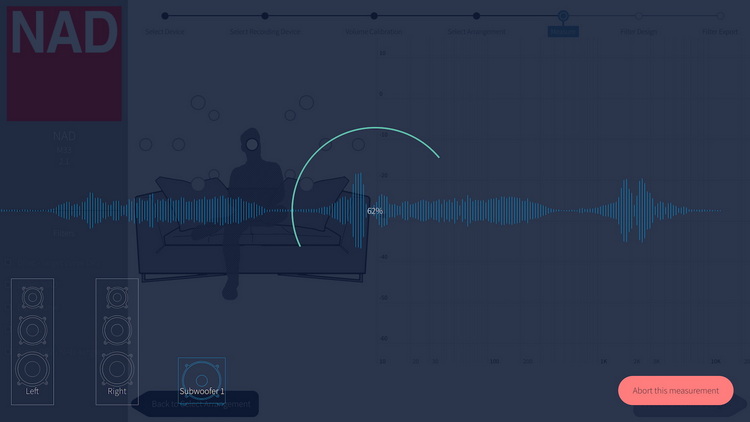
In the next phase, the Dirac software uses the measurement data to create filters that are sent to the amplifier. Such a filter is a digital correction of the audio stream that compensates for various things, such as a cream mode that amplifies a bass frequency. It is optimized to a target curve, a frequency response that is considered ideal. If you want to keep it simple, just choose the filter that Dirac creates immediately based on the Dirac target curve. More interesting, however, is to take the target curve that NAD has made and which can be downloaded from the NAD website (do, it only takes a few seconds). The NAD curve gives a little more body to the bass and is less neutral than what Dirac is aiming for. You get the best result if you tweak that target curve yourself with knowledge of the facts, something you might want to do, for example, because you want to keep the character of your speakers. This is a bit more difficult. For many people, the best option is to have Dirac adjusted by a dealer. That may cost something, but you also get a lot for it. If you want to get started with it yourself, the big plus is that the M33 can switch between five filters that you created with the push of a button. This is useful if you want to compare the result of your own corrections. then the big plus is that the M33 can switch between five filters that you created with the push of a button. This is useful if you want to compare the result of your own corrections. then the big plus is that the M33 can switch between five filters that you created with the push of a button. This is useful if you want to compare the result of your own corrections.
A bit sad is that the M33 comes with a limited Dirac license that only tackles acoustic problems up to 500 Hz. Admittedly, with that you solve most of the tricky things. This license also contains almost all interesting Dirac functionality, such as the correction of the impulse response of the individual drivers of your speakers. So you miss very little. But still, if you want to have Dirac corrected over the entire frequency range, you still have to spend 79 euros extra for a full license.
Does exactly what you want
For our subjective testing, we put the M33 in a few ‘better’ setups. A while with the DALI Rubicon 2, partly with and partly without an additional subwoofer (a MA Silver W12 normally used for surround testing). And then with the Focal Sopra n ° 2’s, large floorstanders that like a good amplifier.
In those three configurations, we performed at least one full Dirac measurement (taking 15-20 minutes of work into account) and created four filters each time: with the classic Dirac curve, with the curve that NAD offers, and then with one or two curves. which we had adjusted ourselves starting from the NAD curve. Adjusting this yourself is not a must, but because we have been working on Dirac and room corrections for some time, we like to dive into it. Incidentally, the full Dirac Live version was used for this test, so with filters that work over the full frequency range, and we work with a UMIK measuring microphone. We usually listened via Roon or BluOS; both streaming options work fine for us.
First observation: we are not going to claim here that the Hegel H390 that we tested some time ago and the NAD M33 offer the same. But there is already one similarity: they are very honest amplifiers that offer a lot of power and control and give the leading role to your speakers. This is a case of class AB versus class D, and a very different view of feedback, and yet a result that is not miles apart.
The addition of Dirac to the NAD story is, in our opinion, a powerful asset. Max Richter’s ‘War Anthem’, a track that is always quickly clicked in our regular test playlist, sounded bigger than ever with an insane depth on the Rubicon 2’s with subwoofer. That mighty artillery-like percussion didn’t sound faint or ignored, it rolled across the room and had the character of something loud very far away. Now the smaller Rubicons do not do badly in terms of bass reproduction as standard, but they remain more compact bookshelf speakers and therefore limited in terms of sub-basses. A subwoofer solves that problem.
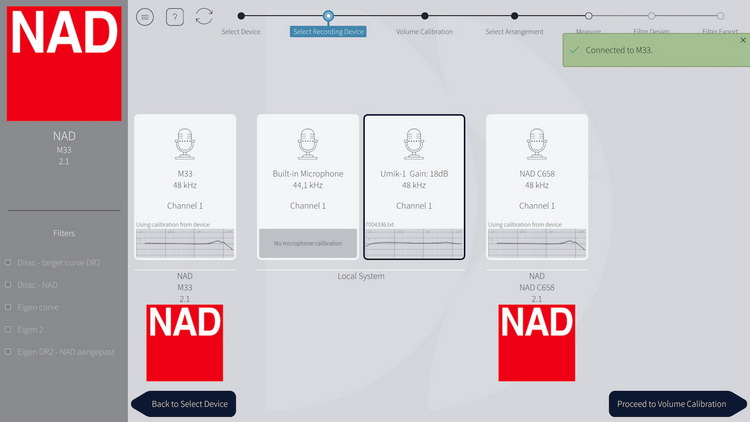
The great thing is that Dirac makes integration just that little bit easier. Of course it always remains a bit more difficult than normal stereo, also in terms of placement, and the test M33 was not quite up to date when it came to subwoofers in terms of software. Will be fine, says NAD. In any case, if you cannot or are not allowed to place large floorstanders, 2.1 is an interesting way to still get a complete sound image. The advantage of those five Dirac slots: you can create a filter for only your two bookshelf speakers and another one for the moments when the subwoofer needs to be added. For those Saturday afternoons when you have the house to yourself and are allowed to turn on the volume knob unhindered, for example.
With a device like the NAD M33 you can keep on talking about functionality and usage scenarios. A lot is possible and due to its extensive options there are a lot of scenarios that suddenly become possible, or at least become feasible. But what about that Eigentakt reinforcement hatch itself? Well – and it may sound irreverent but isn’t it – it amplifies. Subjectively listening we hear the source material and the speakers (and without Dirac: the space), not the M33. It is an experience that comes across as very transparent, because it is not synonymous with analytical or boring-neutral. Very ‘clean’, but not dry, which shifts the spotlight to other parts of the chain.
That is actually a very good thing, but we can imagine that it becomes very confronting when you suddenly replace an older amplifier in your familiar set with the M33. Perhaps those speakers that you have owned for years will sound slightly different. Get to know their straightforward characteristics. That can sometimes take some getting used to. You may now suddenly miss coloring that triggered and appealed to you in the past. At least, we experienced that with our Sopras. Marriage wasn’t bad, it changed. When our Roon playlist ended up at ‘Angel’ by Massive Attack, we knew it was right.
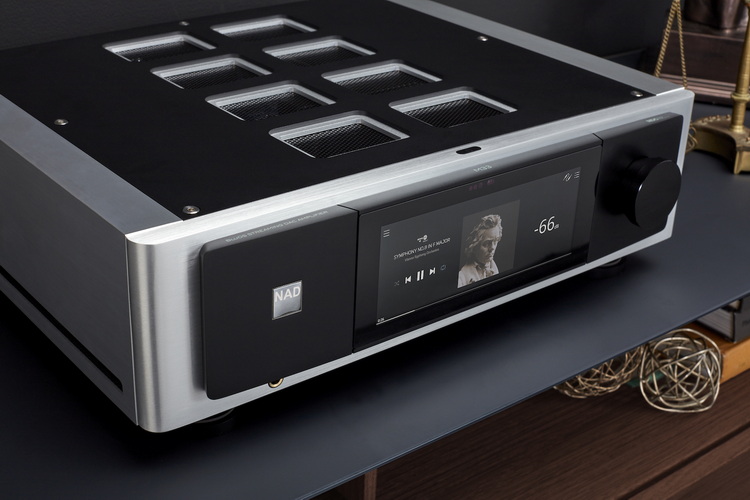
Whether anyone can digest such a sudden change in a relationship, even towards honesty, is of course another question. Perhaps that choice for the M33 will lead to the quest for change in other areas! It’s also important to note that with the DALI Rubicon 2’s we didn’t really experience a dramatic break from other sets. The match with the NAD was even excellent in our space.
At the very end of our test we received something very special: a pair of handsome matte black 1961 Tower speakers from Norway’s Arendal. Just as an experiment we hung these more compact floorstanders on the M33 and opted for the hard work (from previous tests we knew that Arendal digested metal well). Not recorded at all, no Dirac, ‘Departure Songs’ by Australian post-rockers We Lost The Sea at a high volume, and wow, what a tight timing. Should not be more.
Conclusion
The three-way combination of almost effortless Purifi Eigentakt amplification, the versatility of BluOS and the powerful Dirac chamber correction culminates in a hyper-complete amplifier that does not fall short in any way. Where the M10 tried to marry top sound with thorough interior friendliness, the M33 comes with a slightly more traditional shape and especially an amplification section at a higher level. And that without giving up anything in terms of ease of use or functionality. The all-in-one concept has to lie with you and you have to put away any prejudices about class D.
The NAD M33 is also a very modern device, with its smart touch screen, HDMI-ARC connection and integration with smart home platforms. Downsides? Not much. It’s not a cheap amp, but the price tag is right for the segment.
PLUS POINTS of NAD M33
- Powerful enough to control almost anything
- Dirac, including 2.1 correction
- Very complete streaming and multiroom options via BluOS and AirPlay 2
- Transparent and controlled
- One box that does everything
MINUSES of NAD M33
- Higher price range
- Dirac’s threshold is relatively high
